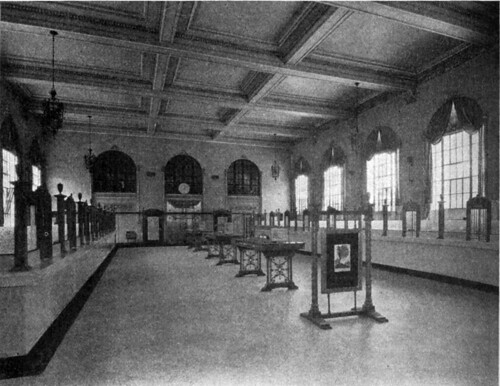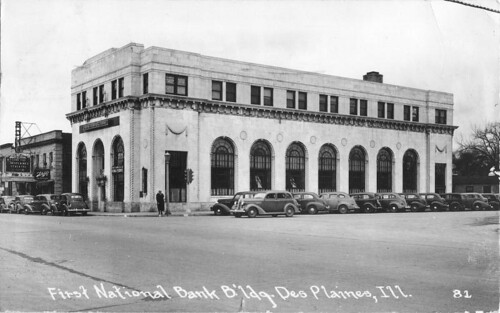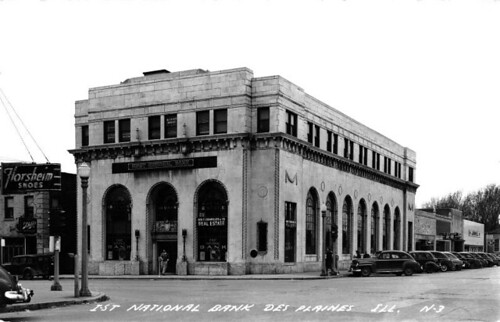
On August 14, Crain's Chicago Business reported that First Banks intends to exit the Chicago market, presumably by selling its branches to another bank. A couple of years ago, First Bank closed its branch at 1401 Lee, near Aldi. They also have an auto bank at 518 Lee, and their main branch is at Lee & Ellinwood, 678 Lee. Given the saturation of banks in Des Plaines, and their desire for drive-through banking, I have to wonder if the next bank will continue to operate the large building with no drive-throughs and enough offices for a headquarters, but probably too many for a branch. Too bad this didn't happen before Kinder Hardware was torn down for the short-lived Des Plaines National Bank (before Midwest Bank absorbed it). Maybe we will see something else go in this building, like what has happened in many of the similarly-sized neighborhood banks in Chicago. The State Bank building is easily one of the most beautiful buildings in the city, and for now has the most beautiful interior downtown.
 The site had previously been land owned by pioneer settler Simeon Lee, the namesake of Lee Street. It once held Des Plaines' first post office - coincidentally, the downtown branch office is now right next door - and then the Scharringhausen family home. The site also contained Des Plaines Lumber and Coal until they moved to the outskirts of the city, Lee Street at the Soo Line tracks, where they built their silos.
The site had previously been land owned by pioneer settler Simeon Lee, the namesake of Lee Street. It once held Des Plaines' first post office - coincidentally, the downtown branch office is now right next door - and then the Scharringhausen family home. The site also contained Des Plaines Lumber and Coal until they moved to the outskirts of the city, Lee Street at the Soo Line tracks, where they built their silos.The Des Plaines State Bank, founded in 1905, was Des Plaines' oldest financial institution (the Bank of Des Plaines was founded in 1897 but did not survive), and was then located in a distinctive Arts and Crafts style building on Ellinwood Street, built in 1915, which also replaced a later post office. Curiously, after this building was converted into a grocery store when the bank left, it was remodeled to give it a greek revival look. It looked more like a bank after it no longer was one.
In 1926, Des Plaines was rapidly expanding; the highway system had brought in a lot of new people. New buildings like the Des Plaines Theatre, Masonic Temple, and First Congregational Church were going up or planned, and new subdivisions were filling out. So it was time for a new home for the Des Plaines State Bank.
They chose the architectural firm of Wolf, Sexton, Harper, and Treaux to design their new building. The firm is now best known for Saint Charles' landmark Hotel Baker. Wolf, Sexton, Harper and Treaux chose an unusual, but attractive look for the building. It is classical in massing and material, with the standard temple look of a bank, but with Spanish detailing. After all, Greek temples don't have arches; that's a Roman invention. The Spanish comes through in the details, where you see the arches flanked by slender, twisting columns. Then there are the Beaux Arts swags and cornice, and some Art Deco inspired details; in all, the building's architecture fits in perfectly with the Theatre and Temple.
When announced in the Chicago Tribune, the building was to be faced in standard Bedford Stone, a common type of limestone found throughout Chicago. Somewhere along the line, this was upgraded to Georgia Marble, a much more impressive and unusual stone more commonly used on monuments like the Lincoln Memorial. The main banking room had a buff colored terrazzo floor, sixteen bankers' cages flanking a 68'x27' lobby, and a coffered plaster ceiling. The large safe with a sixteen inch thick door at the center was by York Safe & Lock Co. of York, PA. The second floor contained eighteen offices with reception rooms; altogether, the building was projected to cost $250,000.
It opened June 11, 1927, but the Des Plaines State Bank didn't last too much longer. The depression hit on Black Thursday, October 24, 1929; on June 13, 1931, the bank failed and closed its doors for good. As a result of the depression, Des Plaines was able to build a new City Hall, Police/Fire Station, and Library, on the site of the old Des Plaines library at Miner and Graceland, where the police department parking lot is now. Of course, this necessitated a temporary home for the library, and what better place than the still-unoccupied State Bank building? The library was located there from 1936 until the new building opened July 30, 1937.

In July, 1937 the bank building was purchased by people who had been depositors in the State Bank; they proposed to rent the main floor out. Instead, First National Bank, located in the old bank building on Miner and the adjacent Gillespie Printery since 1913, opened its doors there October 1, 1937.

It appears that few changes were made, aside from covering up the old State Bank signage with a neon sign and black background; the mast atop the building was also gone by this time. First National remained there for twenty years, until they moved to new, larger facilities at the southeast corner of Lee and Prairie on November 9, 1957.

As First National moved, the Des Plaines National Bank was already waiting in the wings. The rapidly growing city could use another bank, so they seized the opportunity; having organized the previous year, the new bank opened only 5 days after First National. As they moved in, they planned to change the building with complete air conditioning, additional parking, redecorating and remodeling, drive-in banking, and 5,000 safe deposit boxes; it's unclear how many of these were accomplished how quickly, or where they planned on adding drive-in banking. In 1960 they added a parking lot in former park land along the Chicago & Northwestern tracks.
They definitely did add big, obtrusive red neon signs around the building, and embarked on a $150,000 'modernization' program in July, 1961. The architects responsible - and I use that word deliberately - were the local firm of Holmes & Fox, who later designed the Des Plaines Civic Center. All windows were replaced with non-openable ones with white muntins. The original doorway, topped with a decorative metalwork cartouche and spanish detail, was replaced by a plain glass door. The fine ironwork lamps on either side of the lobby were removed. A walk in lobby teller window was added for longer hours than the main lobby. The marble and iron banker's cages were replaced by unbarred counters of rosewood plastic laminate. The lanterns were removed and the coffered ceiling was covered by a lowered drop ceiling with acoustical tile, fluorescent lighting, air ducts, and a sound system. I'm really glad I've never seen a picture of the interior from this era.
 This is the detail that is now lost. It is possible that this is still there, encased in the newer structure.
This is the detail that is now lost. It is possible that this is still there, encased in the newer structure.In the late 1960s, Des Plaines National was looking to leave the building for larger quarters. When they hired Holmes & Fox to design their new auto bank branch at Lee & Perry, it was built with foundations so a multi-story headquarters could be built atop it without effecting operations. Obviously, this never occurred.

To make matters worse, in 1971 the bank added their "heart line" message center, an electronic ticker showing the time, temperature and messages. As you can see, this was incredibly ugly and obtrusive.
In 1974 the bank again hired Holmes & Fox for further remodeling, when railings and platforms in the interior were removed to make staff more accessible, and more safety deposit boxes were added.
By 1984, all that work was not aging well, and planning began for a restoration, of sorts, by Harris, Kwasek & Associates. On the outside, all the signage was removed, the opaque glass above the dropped ceiling was changed to clear, and the muntins were changed to black. The front windows were changed to match the rest of the windows. The marble was also cleaned.
On the interior, the lobby was essentially gutted except for the coffered ceiling. The most drastic change was that the windows on the south wall were bricked in and a mezzanine balcony was added for the entire length of the banking hall. Detailing was added such as a sculpted balcony face, brass railings and balustrades, and planters. Overall, the effect is very sympathetic to the original interior, but really, the only parts of the original left are the ceiling and the safe. Even the applied moldings on the walls are gone.
In 1988 the bank's name was changed to Plainsbank of Illinois as an Elk Grove branch was added, and in 2001, it was sold to First Banks, which added much smaller signage to the building and later added a walk-up ATM.









0 comments:
Post a Comment
Please be civil and constructive!